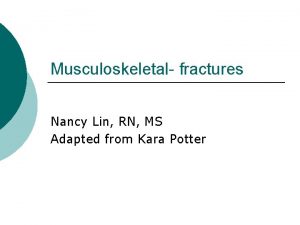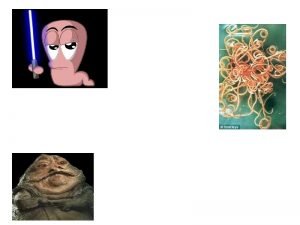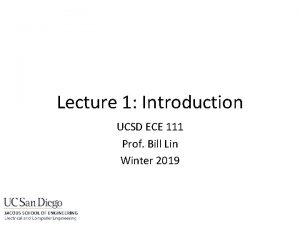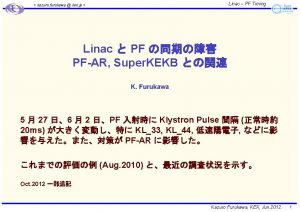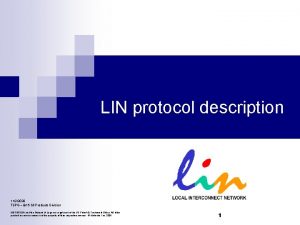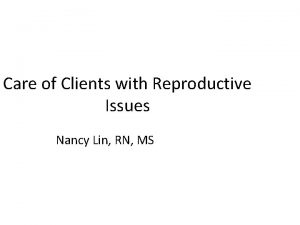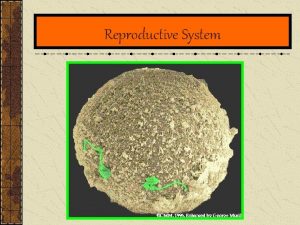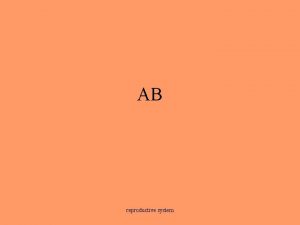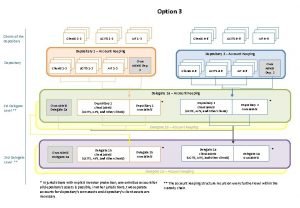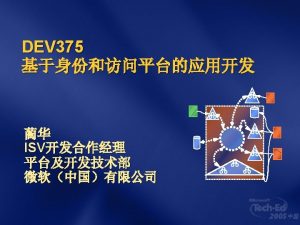Care of Clients with Reproductive Issues Nancy Lin





























































- Slides: 61

Care of Clients with Reproductive Issues Nancy Lin, RN, MS

Student Learning Outcomes • • • Discuss nursing care of pediatric clients with defects of the genitourinary tract Analyze clinical manifestations, pathophysiology, clinical treatment and nursing management of common women’s gynecologic issues. Compare common gynecologic surgeries. Differentiate problems related to menstruation Examine nursing care of clients with Pelvic Inflammatory Disease, endometriosis, cervical cancer, and ovarian cancer Describe the collaborative and nursing care of clients with various gynecologic surgeries. Discuss nursing care of clients affected by sexual assault. Analyze clinical manifestations, pathophysiology, clinical treatment and nursing management of male reproductive tract and urology issues including: Erectile Dysfunction, BPH, and TURP. Identify pharmacologic interventions for clients with GU problems

Defects of Genitourinary Tract • Obvious at birth • Early correction of visible genital defects – preferably w/o multiple-stage repairs • Surgery involving sexual organs • particularly disruptive to preschoolers

Cryptorchidism • • Undescended testes Most common congenital testicular condition May occur bilaterally or unilaterally May be cause of infertility • if corrective surgery not done by 2 years of age • Incidence of testicular cancer higher • if condition not corrected before puberty • Clinical Manifestations • Therapeutic Management • surgery performed to locate & suture testis or testes to scrotum

Hypospadias • Urethral opening located below glans penis or anywhere along ventral surface of penile shaft • Causes: – hormonal influences in utero – Environmental factors – Genetic factors • Surgical correction • Preferred time for surgical repair: 6 -12 mos of age • Nursing care management

Ambiguous Genitalia • Potential lifetime social strategy for child & family • Disturbances in normal order of event in gender determination • produce abnl genitalia & reproductive organ development w/presence of ambiguous or indeterminate external genitalia at birth • Can be variable & may often closely conform to one gender or the other

Ambiguous Genitalia • Four conditions – – masculinized female incompletely masculinized male presence of both male & female sexual organs mixed gonadal dysgenesis • Nursing care management – Best approach is honesty

Circumcision • Surgical removal of foreskin on glans penis • Risks & benefits

Problems Related to Menstruation • Premenstrual syndrome (PMS) Common disorder in women A group of physical & psychological sx occur during last few days of menstural cycle & before onset of menstruation • Etiology & Pathophysiology • Clinical Manifestations • Diagnostic Studies & Collaborative Care

Problems Related to Menstruation • Dysmenorrhea – Abd cramping pain or discomfort associated with menstrual flow – One of most commom gynecologic problems, – Affect approx. 50% of all women • Etiology & Pathophysiology Primary dysmenorrhea Secondary dysmenorrhea ● Collaborative Care

Problems Related To Menstruation • Premenopause: may last >5 yrs before true menopause occurs • Menstrual variations • Sudden episodes of vasodilation • Vaginal dryness • Changes probably caused by alterations in hypothalamic-pituitary-ovarian feedback system

Menopause • Permanent end of menstruation caused by decreased ovarian function • After 1 yr of amenorrhea (absence of menstruation) • Avg age 51 yrs • Clinical Manifestations

Therapy for Menopause • Hormone replacement therapy (HRT) • Most prevalent treatment • Oral estrogen taken together with synthetic hormone progestin • Progestin added – To minimize risk of endometrial hyperplasia & endometrial cancer from use of estrogen alone – Potential negative effects of progestins

Therapy for Menopause • Women’s Health Initiative trial – HRT should not be prescribed for long-term prevention of chronic dz – HRT associated w/inc. risk of breast CA, thromboembolism, coronary artery dz & stroke – should only be used for treatment of menopausal symptoms at lowest dose & shortest duration possible

Pelvic Inflammatory Disease • Infectious condition of pelvic cavity • Infection of fallopian tubes, ovaries, and pelvic peritonium • “silent” – women do not perceive any symptoms

Etiology & Pathophysilogy • Often result of untreated cervicitis • Most common organisms: _____ • _______ infections can be asymptomatic & unknowingly transmitted during intercourse • Silent PID can cause irreversible damage • Major cause of female infertility

Clinical Manifestations: PID • Lower abd pain – Pain usually starts gradually & is constant – Pain with intercourse • Spotting after intercourse • Purulent cervical or vaginal discharge • Fever & chills

Complications of PID • • • Septic shock Fitz-Hugh-Curtis Syndrome Tubo-ovarian abscesses Thrombophlebitis of pelvic veins Long-term complications – Ectopic pregnancy – Infertility – Chronic pelvic pain • Adhesions & strictures in fallopian tubes

Collaborative Care: PID • • • Usually treated on outpatient basis Abx – Cefoxitin & doxycycline No intercourse for ____ weeks Examine & treat her partner(s) Physical rest & oral fluids Hospitalization if tubal-ovarian abscess present

Nursing Management: PID • Prevention, early recognition & prompt treatment of vaginal & cervical infections • Seek prompt medical attention • Unusual vaginal discharge • Possible infection of reproductive organs

Endometriosis • Presence of normal endometrial tissue in sites outside endometrial cavity • Most frequent sites: in or near ovaries, uterosacral ligaments & uterovesical peritoneum • Typical pt: • late 20 s or early 30 s, white, • never had full-term pregnancy • Etiology

Clinical Manifestations of Endometriosis • Dysmenorrhea • Secondary dysmenorrhea

Collaborative Care: Endometriosis • Laparoscopy • Drug therapy: – used to reduce symptoms – inhibit estrogen production by ovary → shrink endometrial tissue – controlled but not cured by hormonal therapy • Surgical removal is only cure

Pharmacologic Therapy for Endometriosis • Danazol (Danocrine) – med of choice for endometriosis • Commonly used for women w/infertility associated with endometriosis • May be used for PMS

Cervical Cancer • 10, 370 women in U. S. have invasive cervical cancer & 3, 700 women die annually • African American: 2 x Mortality rate

Etiology and Pathophysiology: Cervical Ca • Strong relationship between sexual exposure of ____ virus and dysplasia • Increased risk associated with – Low socioeconomic status – Early sexual activity – Smoking

Clinical Manifestations: Cervical Cancer • Precancerous changes: asymptomatic • Routine screening very important

Diagnostic Studies: Cervical Ca • Pap test at least once every 3 yrs, beginning 3 yrs after 1 st sexual intercourse, but no later than age 21.

Diagnostic Studies: Cervical Ca • Colposcopy – Direct visualization of cervix with binocular microscope – Allows magnification & study of cellular dysplasia & vascular & tissue abnl of cervix

Collaborative Care: Cervical Ca • Vaccine – 3 shots over 6 months • Surgery, radiation & chemo as single treatments or in combination

Ovarian Cancer • Malignant neoplasm of ovaries • 4 th leading cause of cancer deaths in women in U. S. • Cause unknown • Greatest risk factor • Other risk factors • Use of _______ assoc. w/lower ovarian cancer risk

Clinical Manifestations: Ovarian Ca • Early stages – – – Vague sx General abd discomfort Sense of pelvic heaviness Loss of appetite Change in bowel habits • As malignancy grows – Inc. in abd girth – Bowel & bladder dysfunction – Persistent pelvic or abd pain – Menstrual irregularity – Ascites – Abnl vag bleeding

Diagnostic Studies for Ovarian Cancer • No screening test exists • Yearly bimanual pelvic exam • Abd or transvaginal US

Surgical Procedures: Female Reproductive System • HYSTERECTOMY – Total Hysterectomy – Total abdominal hysterectomy & bilateral salpingo-oophorectomy (TAH-BSO)

Collaborative care of clients with gynecologic surgeries • Preop – Prepare pt physically for surgery • Provide psychologic support

Gynecologic Surgeries • Salpingectomy: removal of a ______ • Oophorectomy: removal of ______ Surgical menopause results when both ovaries are removed (bilateral oophorectomy)

Nursing care of clients after hysterectomy • Nursing diagnosis • Interventions – Observe dressing freq for sx of bleeding – Monitor for urine retention & abd distention – Prevent development of DVT – Discharge teaching

Uterine Prolapse • Downward displacement of uterus into vaginal canal • Therapy depends on degree of prolapse & how much client’s daily activities have been affected • Pelvic muscle strengthing exercises (Kegel exercises) • Pessary • Surgery

Sexual Assault • Forcible perpetration of a sexual act on a person without his or her consent • Physical manifestations • Psychologic manifestations

Collaborative & Nursing Care • Ensure client emotional & physical safety • Do not clean client until all evidence collected – Do not wash, douche, urinate, brush teeth, or gargle • Obtain forensic evidence per local protocol • Obtain baseline HIV, syphillis & other STD screening

Problems of the Prostate Gland • Benign prostatic hyperplasia (BPH) – Enlargement of prostate gland – from increase in number of epithelial cells & stromal tissue – Most common urologic problem in male adults – Does not predispose individual to develop prostate cancer

Etiology & Pathophysiology: BPH • Cause not completely understood • Endocrine changes associated with aging process • No direct relationship between size of prostate & degree of obstruction • Location of enlargement most significant in development of obstructive symptoms

Risk factors for BPH • Family history • Obesity • Diet

Clinical Manifestations: BPH • Symptoms usually gradual in onset • What are the symptoms? ? ?

Complications: BPH • • • Acute urinary retention UTI & potentially sepsis secondary to UTI Incomplete bladder emptying Calculi Renal failure caused by hydronephrosis Bladder damage if treatment for acute urinary retention delayed

Diagnostic Studies: BPH • Digital rectal exam (DRE) • Prostate-specific antigen (PSA) • Transrectal ultrasound scan in patients with an abnormal DRE & elevated PSA

Collaborative Care: BPH • “watchful waiting” with no symptoms or mild symptoms • Early detection & treatment • Diet changes • Limit ETOH & caffeine • Avoid meds such as decongestants & anticholinergics • Urinate when first feel urge • Restrict evening fluid intake

Drug Therapy for treatment of BPH • 5 Alpha-Reductase Inhibitors – Finasteride (Proscar), Durastride (Avodart, Duragon) – Reduce size of prostate gland – Regression of hyperplastic tissue through suppression of androgens – Takes 3 to 6 months to be effective – Take on continuous basis – Side effects

Drug Therapy for BPH • Alpha-Adrenergic Blocking Agents • Tamsulosin (Flomax); Doxazosin (Cardura); Terazosin (Hytrin) • Alfuzosin (Uroxatral) – Side Effects • Promote smooth muscle relaxation in prostate → facilitates urinary flow through urethra • 50% to 60% efficiency in improvement of symptoms • Improvement of symptoms within 2 to 3 weeks

Herbal Therapy for BPH • • Plant extracts: Saw Palmetto Improve urinary symptoms & urinary flow measures Nursing implications: Caution in clients with GI disease – May increase risk of bleeding • Contraindicated before surgical or dental procedures • May increase BP

Invasive Therapy: BPH • Indication: • Decrease in urine flow sufficient to cause discomfort • Persistent residual urine • Acute urinary retention with no reversible precipitating cause • Hydronephrosis

Invasive Therapy: BPH • Transurethral Resection of Prostate (TURP): surgical procedure involving removal of prostate tissue using a resectoscope inserted through urethra • “gold standard” surgical treatment for obstructing BPH

Preoperative Care: BPH • • • Restore urinary drainage before surg Encourage hi fluid intake Coude (curved-tip) catheter Treat any UTIs Provide opportunity for pt & partner to express concerns on sexual functioning after surg

Postoperative Care: BPH • Major complications – Hemorrhage, bladder spasms, urinary incontinence & infection – Use careful aseptic technique – Blood clots expected 24 to 36 hrs after surg – Bladder may take up to 2 months to return to nl capacity

Erectile Dysfunction • Inability to attain or maintain an erect penis • 20 to 30 million men in U. S. experience ED • Can occur at any age, incidence increases with age • Can be affected by substance abuse in younger men

Etiology & Pathophysiology: ED • • Physiologic ED Diabetes mellitus Vascular disease Side effects from medications Result of surgery (prostatectomy) Trauma Chronic illness Decreased gonadal hormone secretion

Etiology & Pathophysiology of ED • • • Psychologic ED Stress Difficulty in a relationship Depression Low self-esteem

Meds Causing Sexual Dysfunction in Males • • Anticholinergics Antidepressants Antihistamines Antihypertensives Antipsychotics Sedatives & social drugs Others

Collaborative Care of ED • Drug therapy: • Levodopa: – Effective in stimulating libido & treating erectile dysfunctions in non-Parkinson’s pts. • Viagra, Cialis, Levitra – contraindicated for patients taking nitrates • • Vacuum Constrictive Devices Intraurethral Devices Penile Implants Sexual Counseling

Read/Review: Genital herpes & Syphilis (ATI) • Lewis: pp. 1264 -1266; pp. 1267 -1269 – this content will NOT be on N 003 exams

References Adams, M. P. , & Urban, C. Q. (2013), Pharmacology : Connections to nursing practice (2 nd ed. ) Boston: Pearson Education, Inc. Hockenberry, M. J. & Wilson, D. (2015). Nursing care of infants and children (10 th ed. ). St. Louis, MO: Mosby. Lewis, S. , Heitkemper, M. & Dirksen, S. (2014). Medical Surgical Nursing: Assessment and Management of Clinical Problems (9 th ed. ). St. Louis, MO: Mosby Touhy, T. & Jett, K. (2014). Ebersole & Hess’ Gerontological Nursing Healthy Aging (4 th Ed. ). St. Louis: Mosby/Elsevier
 Bucks traction
Bucks traction Level of care primary secondary tertiary
Level of care primary secondary tertiary How to care reproductive system
How to care reproductive system Clients often criticize public relations firms for
Clients often criticize public relations firms for Recruiting cold call script
Recruiting cold call script Déontologie
Déontologie Flux de données clients
Flux de données clients Typologie des clients insatisfaits
Typologie des clients insatisfaits Ibm thin client
Ibm thin client How to schedule appointments with clients
How to schedule appointments with clients Trauma-informed questions for clients
Trauma-informed questions for clients Social work client assessment questions
Social work client assessment questions Nudge for clients
Nudge for clients From a multicultural perspective some clients
From a multicultural perspective some clients Characteristics of a profession
Characteristics of a profession Bi vs dss
Bi vs dss Adlerian basic mistakes examples
Adlerian basic mistakes examples Counseling multicultural clients
Counseling multicultural clients Prospecting and qualifying
Prospecting and qualifying Chapter 15 scalp care, shampooing, and conditioning
Chapter 15 scalp care, shampooing, and conditioning Clients needs assessment
Clients needs assessment Gnutella clients
Gnutella clients Nachteile thin clients
Nachteile thin clients Web essentials
Web essentials 18 golden rules of human relations
18 golden rules of human relations Idt clients
Idt clients Facade pattern couples a subsystem from its clients
Facade pattern couples a subsystem from its clients Appipay service en ligne
Appipay service en ligne Ethical issues in palliative care
Ethical issues in palliative care Unlv rebel grad slam
Unlv rebel grad slam Va dơ lin
Va dơ lin Meddi lazım karabaş tecvidi
Meddi lazım karabaş tecvidi Dr vivian lin
Dr vivian lin Modelo logaritmico econometria
Modelo logaritmico econometria Alison lin nci
Alison lin nci Aperture stop
Aperture stop Hanti lin
Hanti lin Constance lin
Constance lin Lin donn
Lin donn Dr calvin lin
Dr calvin lin Olinowanie ruchome jachtu
Olinowanie ruchome jachtu Kaylee lin
Kaylee lin Lin evola-smidt
Lin evola-smidt Revm örneği
Revm örneği Bill lin ucsd
Bill lin ucsd Penforlds
Penforlds Dr karen lin
Dr karen lin 5 examples of antivirus
5 examples of antivirus Lu lin uva
Lu lin uva Cu lin
Cu lin Chi lin purse
Chi lin purse Xika lin
Xika lin Ram nam me lin hai dekhat sabme ram
Ram nam me lin hai dekhat sabme ram Magistrala lin bmw
Magistrala lin bmw Linda mei-lin koh
Linda mei-lin koh [email protected]
[email protected] Lin message frame
Lin message frame Hi lin
Hi lin Autosar lin
Autosar lin Lin win ru
Lin win ru Mot lin blinds
Mot lin blinds Lin donn
Lin donn
